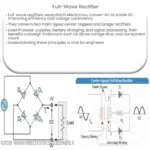Explore the rectifier equation, its significance in electronics, different types of rectifiers, and an example calculation.
Understanding Rectifiers and Their Importance in Modern Electronics
Rectifiers are vital components in electronics, primarily responsible for converting alternating current (AC) into direct current (DC). This process, known as rectification, is crucial for powering many electronic devices that require a stable DC voltage. In this article, we will delve into the fundamental equation governing rectifiers and explore its significance without delving into specific calculations.
The Rectifier Equation
The equation governing rectifiers is defined as:
VDC = Vm x k
where:
- VDC represents the output DC voltage
- Vm denotes the peak value of the input AC voltage
- k is a constant that depends on the type of rectifier
It is essential to understand that the value of k varies based on the kind of rectifier used. For example, in a half-wave rectifier, k is approximately 0.318, while in a full-wave rectifier, k is close to 0.636. The equation reflects how the output DC voltage is influenced by the input AC voltage and the rectifier design.
Types of Rectifiers and Their Applications
There are several types of rectifiers commonly used in electronic circuits. We’ll briefly discuss the most prevalent ones and their applications:
- Half-Wave Rectifiers: These rectifiers use a single diode to allow only half of the input AC waveform to pass through, resulting in a pulsating DC output. They are typically employed in low-power applications or as a cost-effective solution for voltage regulation.
- Full-Wave Rectifiers: These rectifiers employ two or four diodes to enable both halves of the input AC waveform to contribute to the output DC voltage, resulting in a smoother DC output. Full-wave rectifiers are used in various applications, including power supplies for sensitive electronics and radio frequency (RF) signal detection.
- Bridge Rectifiers: Bridge rectifiers use four diodes in a bridge configuration to achieve full-wave rectification. They are commonly found in power supplies for consumer electronics, automotive charging systems, and power distribution networks.
Conclusion
Rectifiers play a crucial role in modern electronics, converting AC voltage into a stable DC output for powering a myriad of devices. The rectifier equation helps engineers and hobbyists alike understand the relationship between the input AC voltage, the type of rectifier used, and the resulting DC output voltage. With this fundamental understanding, we can better design and optimize electronic circuits for a wide range of applications.
Example Calculation for a Full-Wave Rectifier
Let’s assume we have a full-wave rectifier with an input AC voltage of 230V RMS (root-mean-square). We’ll calculate the output DC voltage for this specific rectifier.
First, we need to find the peak value of the input AC voltage (Vm). The relationship between RMS and peak value for a sinusoidal waveform is as follows:
Vm = VRMS x √2
By plugging in the given RMS value:
Vm = 230V x √2 ≈ 325V
Next, we’ll use the rectifier equation to calculate the output DC voltage (VDC). As mentioned earlier, for a full-wave rectifier, the value of k is approximately 0.636.
VDC = Vm x k
Substituting the calculated values:
VDC = 325V x 0.636 ≈ 206.7V
Therefore, the output DC voltage for the full-wave rectifier with a 230V RMS input is approximately 206.7V.
This example demonstrates the practical application of the rectifier equation in calculating the output DC voltage for a specific rectifier based on the input AC voltage and rectifier type.




